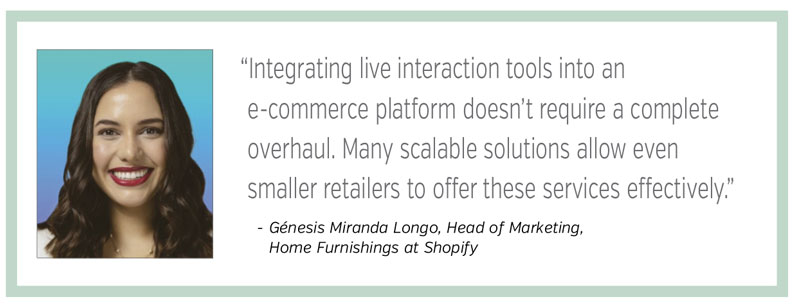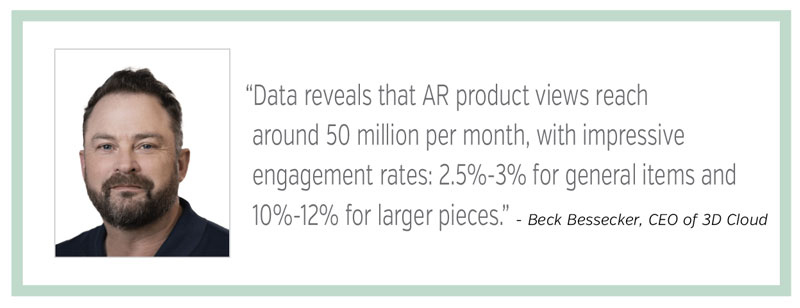With the right strategies and tools, retailers can elevate their online presence and drive lasting success, said
a panel
of experts assembled by HFA.
Today’s retailers face a dual e-commerce challenge. They must stand out in a sea of competitors while adapting
to the
ever-shifting expectations of digital shoppers. Success in this environment requires more than just listing
products
online—it demands a strategic approach to merchandising that captures attention, builds trust, and drives
conversions.
In this article, we’ll delve into proven online merchandising strategies that can help you enhance your store’s
appeal,
engage your audience, and ultimately boost sales.
HFA assembled a panel of e-commerce experts, including Beck Bessecker, CEO of 3D Cloud; Ian Leslie, CMO of
Industry
West; Génesis Miranda Longo, Head of Marketing for Home Furnishings at Shopify; and Laura Khoury, CEO of
Shoptelligence;
to discuss the challenges and opportunities facing furniture retailers.
“When you use their input to make immediate improvements, it elevates the shopping experience and builds
trust and
loyalty.” - Laura Khoury, CEO, Shoptelligence
Augmented Reality & 3D
Bessecker, an expert in 3D content management, underscored the transformative role of AR in enhancing consumer
decisions, especially for large-ticket items like sofas and dining tables. Data reveals that AR product views
reach
around 50 million per month, with impressive engagement rates: 2.5%-3% for general items and 10%-12% for larger
pieces.
“AR is an engaging tool, often called an entertaining tape measure, significantly boosting purchase rates,” he
explained. “The tactile visualization provided by AR allows consumers to see how items fit within their spaces,
mitigating buyer uncertainty and minimizing returns. For example, brands like LoveSac have harnessed AR to
promote
customizable furniture, seeing notable sales increases.

High-Res 2D Images & Live Consultations
While AR is a powerful tool for enhancing the online shopping experience, it’s not a practical option for every
retailer
due to its cost and technical demands. Leslie shared an alternative approach that has worked exceptionally well
for
Industry West Furniture: leveraging high-resolution 2D images. He emphasized that these images aren’t just about
visual
appeal—they are a tool for building consumer trust. Features like close-up shots, lifestyle settings, and
dynamic angles
enable shoppers to envision how a product fits into their space without needing augmented reality. This
budget-friendly
strategy underscores the importance of presenting products in a tangible way, even in a digital format.
Similarly, Shopify’s Longo highlighted the transformative potential of live consultations in online
merchandising.
“Engaging directly with customers through live chat or video,” she explained, “brings a human touch to the
digital
shopping experience, mirroring the personalized service traditionally found in brick-and-mortar stores. Live
consultations allow retailers to address customer concerns in real time, answer product-specific questions, and
provide
tailored recommendations based on individual needs and preferences. This enhances the shopper’s confidence in
their
purchase decisions and fosters a deeper connection and trust between the customer and the brand.”
Longo pointed out that integrating live interaction tools into an e-commerce platform doesn’t require a complete
overhaul. Many scalable solutions allow even smaller retailers to offer these services effectively. For
instance, a home
furnishings retailer might use video consultations to guide customers through fabric selections, demonstrate
furniture
assembly, or discuss room layout ideas, turning what could have been a hesitant shopper into a confident buyer.
“Consumers crave authenticity and personalization,” she continued. “When you meet them where they are—whether
it’s a
quick chat for reassurance or a detailed video consultation—it creates a memorable and engaging experience that
sets
your brand apart.”

Automation & AI For Online Merchandising
Automation and AI have become cornerstones of efficient and effective online merchandising, transforming how
retailers
manage their digital storefronts. Leslie highlighted the value of platforms like Nosto (www.nosto.com), which
leverage
AI to streamline key aspects of merchandising. These tools reduce the need for manual input, allowing retailers
to focus
on strategy and creativity while the system handles product placement, personalization, and recommendations.
Nosto and similar platforms like Shoptelligence analyze vast amounts of data—from browsing behaviors to purchase
patterns—to optimize the shopping experience in real time. For example, AI-driven algorithms can automatically
curate
product recommendations tailored to each visitor, showcasing items most likely to align with their preferences
and
purchase intent. This enhances the customer experience and drives higher conversion rates by presenting the
right
products at the right time.
Another strength of AI-powered platforms is their ability to adapt quickly to trends and inventory changes. If a
particular product starts selling out, AI can reconfigure merchandising strategies, highlighting similar items
or
pulling from complementary categories to maintain sales momentum. Automation can also dynamically adjust
banners,
collections, and featured products based on real-time performance data, ensuring every storefront element
remains
relevant and engaging.
“Retailers often worry that automation will take the human touch out of merchandising, but the opposite is true,”
noted
Khoury. “AI enhances the shopping experience by making it more personalized and efficient while freeing up teams
to
focus on storytelling, design, and other creative pursuits that build brand identity.”
Automation facilitates streamlined operations, allowing for real-time merchandising updates and personalized
experiences. She emphasized the importance of investing in tools that can effectively leverage and enhance
photography
efforts. “Great photography is the foundation of successful online merchandising,” Khoury explained. “But to
truly stand
out, retailers need tools that can dynamically leverage those visuals to create engaging, personalized
experiences.”
Automation bridges this gap using AI and data analytics to tailor product presentations to individual customer
preferences.
For instance, tools powered by automation can analyze a shopper’s browsing history to curate personalized product
recommendations, using compelling images to highlight complementary or alternative items. Similarly, automated
solutions
can adapt product displays in real time based on trends, stock levels, or seasonality, ensuring customers always
see the
most relevant and appealing options.
She also emphasized how automation can amplify the value of photography efforts by integrating visual assets
seamlessly
across multiple platforms. For example, a single set of professional images can be automatically resized,
optimized, and
deployed across a retailer’s website, social media channels, and email campaigns. This ensures consistent
branding and
maximizes the return on investment in visual content.

“Investing in the right tools doesn’t just save time—it elevates the entire shopping experience,” she continued.
“Automation allows retailers to focus less on manual processes and more on strategic efforts, like storytelling
through
visuals and building stronger connections with customers.”
By combining automation with compelling photography, retailers can create an immersive, visually engaging
environment
that feels as dynamic and tailored as a high-end showroom—all while reducing operational burdens. This approach
enhances
the customer experience, drives higher conversion rates, and fosters long-term loyalty.
Omnichannel & Unified Commerce
Creating a seamless customer journey involves integrating online and offline experiences. Longo advocated for
unified
commerce, going beyond traditional omnichannel approaches by integrating operations, data, and systems to foster
a
cohesive customer experience.
A unified commerce strategy promotes growth, operational efficiency, and improved customer journeys. For example,
understanding online behavior, such as abandoned carts, can help refine the in-store experience, ultimately
driving
higher sales.
Personalization
Personalization is a fundamental aspect of modern e-commerce. From simplifying the user journey to overcoming
decision
fatigue, tailored experiences can significantly boost customer satisfaction and sales. HFA’s panelists weighed
in
regarding this topic.
Khoury highlighted the necessity of embedded personalization throughout the shopping experience, particularly in
the
furniture industry. Technologies facilitating this, such as AI-driven recommendations and self-service
configurators,
enable customers to navigate options more easily.
Bessecker pointed to the potential future of personalization with AI and natural language interfaces, predicting
even
more intuitive and tailored consumer interactions. Encouraging users to identify their role (e.g., homeowner,
designer,
contractor) can further enhance personalized experiences by providing relevant insights and recommendations.

Building and Promotions During Peak Seasons
Shopify’s Longo mentioned the importance of bundling discounts during major sales events like Black Friday and
Cyber
Monday. These strategic promotions can drive significant sales in the home furnishings sector. Using customer
insights
to guide merchandising decisions, such as product comparisons and new product testing, can further enhance the
effectiveness of these promotions.
Real-Time Feedback & Updates
Leveraging real-time customer feedback is a game-changing strategy for improving online merchandising
effectiveness. By
actively listening to and analyzing customer input, whether through reviews, live chat interactions, or
post-purchase
surveys, retailers can make immediate updates to their online store, ensuring that customer needs and
preferences are
swiftly addressed.
This responsiveness goes beyond resolving individual concerns; it enables businesses to identify and act on
broader
trends. For example, if multiple customers mention confusion about product dimensions in reviews, this feedback
can
prompt the immediate addition of a detailed dimensions chart to the product page. Similarly, if shoppers express
interest in specific features not highlighted in product descriptions, these details can be updated in real
time,
enhancing clarity and boosting confidence in purchase decisions.
Real-time feedback loops also allow retailers to refine their product offerings and merchandising strategies. By
tracking which items receive the most praise or complaints, retailers can adjust inventory, update marketing
strategies,
or spotlight high-performing products to capitalize on their popularity.
“Customers want to feel heard, and their feedback is a goldmine of actionable insights,” concluded Khoury. “When
you use
their input to make immediate improvements, it elevates the shopping experience and builds trust and loyalty.
Shoppers
are more likely to return when they see tangible responses to their suggestions.”
Additionally, incorporating customer feedback into personalization efforts can significantly enhance engagement.
For
instance, feedback-driven algorithms can recommend products based on recent preferences shared by shoppers,
offering a
tailored experience that mirrors the attentiveness of in-store interactions.
Implementing tools like sentiment analysis, real-time analytics dashboards, or direct integration of reviews into
the
online merchandising platform makes this process scalable and efficient. Retailers that excel in responsiveness
create a
cycle of continuous improvement that keeps their digital storefront dynamic, relevant, and aligned with their
audience’s
expectations.
In an increasingly competitive online landscape, this ability to pivot quickly based on customer insights can
make the
difference between a good and great store. By maintaining high satisfaction and loyalty levels, retailers
attract more
buyers and encourage repeat purchases, strengthening their long-term success.
Practical Tips & Effective Strategies
-
Establish a Strong Foundation: Before experimenting with advanced tools like AR/VR,
ensure your platform is robust and
adaptable. This solid foundation will support the successful scaling of new technologies.
-
Measure Investment Impact: Track and analyze the ROI of your merchandising investments.
Laura Khoury emphasizes the
significance of optimizing based on data-driven insights.
-
Continuously Engage With Customers: Utilize interactive Product Detail Pages (PDPs) to
enhance engagement. As Ian Leslie
and Laura Khoury suggest, incorporating tools like style quizzes, configurators, and visualizers can
increase dwell time
and drive conversions.

Conclusion
Excelling in online merchandising requires a blend of innovative tools, strategic approaches, and a commitment to
personalization. By leveraging technologies like AR, AI-driven automation, and live consultations, retailers can
create
engaging, efficient, and tailored shopping experiences that resonate with modern consumers. A unified commerce
strategy
further strengthens the customer journey, seamlessly integrating online and offline touchpoints. Real-time
feedback
loops and data-driven insights ensure businesses remain agile, continually adapting to shopper preferences.
Effective
online merchandising is about more than just showcasing products. It’s about building trust, fostering loyalty,
and
setting your brand apart in a competitive digital landscape. With the right strategies and tools, retailers can
elevate
their online presence and drive lasting success.
About HFA:
HFA is a trade organization dedicated to serving furniture retailers. Our mission of service is built on
Community, Advocacy, Resources, and Education to support retailer interests and the success of the home
furnishings
industry. HFA provides members with programs, resources, services, and a unified voice in government
relations. For more
information about HFA and its programs, visit
www.myhfa.org.